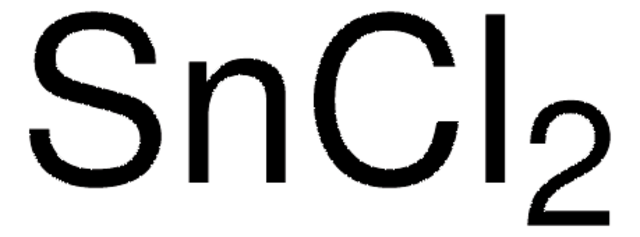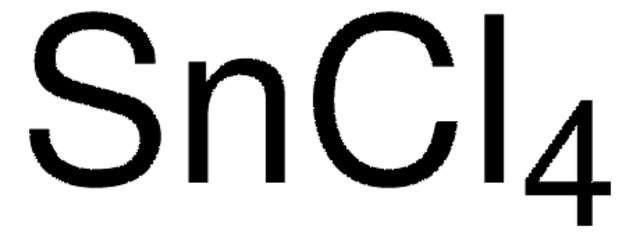474762
Tin(II) chloride dihydrate
≥99.97% trace metals basis
Synonyme(s) :
Stannous dichloride dihydrate, Stannous chloride dihydrate
About This Item
Produits recommandés
Niveau de qualité
Essai
≥99.97% trace metals basis
Pertinence de la réaction
core: tin
reagent type: catalyst
pb
652 °C (lit.)
Pf
37-38 °C (dec.) (lit.)
Chaîne SMILES
O.O.Cl[SnH2]Cl
InChI
1S/2ClH.2H2O.Sn/h2*1H;2*1H2;/q;;;;+2/p-2
Clé InChI
FWPIDFUJEMBDLS-UHFFFAOYSA-L
Vous recherchez des produits similaires ? Visite Guide de comparaison des produits
Catégories apparentées
Application
- 3-Aminoimidazo[1,2-a]pyridines via three-component condensation reaction of aromatic aldehydes, 2-aminopyridines, and isonitriles.
- Pyrazolo[5,4-b]quinoline derivatives via cyclocondensation reaction of 5-amino-3-(arylamino)-1H-pyrazole-4-carbonitriles with cyclohexane-1,3-dione or dimedone.
- Polylactic acid from aqueous lactic acid in the presence of succinic anhydride.
It can also be used as a cocatalyst to synthesize indole derivatives by treating anilines with trialkanolamines in the presence of ruthenium as a catalyst.
Mention d'avertissement
Danger
Mentions de danger
Classification des risques
Acute Tox. 4 Inhalation - Acute Tox. 4 Oral - Aquatic Chronic 3 - Eye Dam. 1 - Met. Corr. 1 - Skin Corr. 1B - Skin Sens. 1 - STOT RE 2 Oral - STOT SE 3
Organes cibles
Cardio-vascular system, Respiratory system
Code de la classe de stockage
8B - Non-combustible corrosive hazardous materials
Classe de danger pour l'eau (WGK)
WGK 3
Point d'éclair (°F)
Not applicable
Point d'éclair (°C)
Not applicable
Équipement de protection individuelle
Eyeshields, Faceshields, Gloves, type P3 (EN 143) respirator cartridges
Faites votre choix parmi les versions les plus récentes :
Déjà en possession de ce produit ?
Retrouvez la documentation relative aux produits que vous avez récemment achetés dans la Bibliothèque de documents.
Les clients ont également consulté
Notre équipe de scientifiques dispose d'une expérience dans tous les secteurs de la recherche, notamment en sciences de la vie, science des matériaux, synthèse chimique, chromatographie, analyse et dans de nombreux autres domaines..
Contacter notre Service technique








